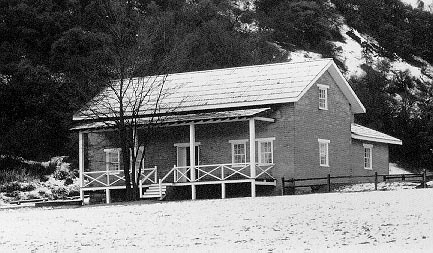 |
 |
 |
 |
 |
|
| HISTORY
OF FORT TEJON |
| by
George Stammerjohan |
| |
Fort Tejon
is located in the Grapevine Canyon, the main route
between California's great central valley and Southern
California. The fort was established to protect
and control the Indians who were living on the
Sebastian Indians Reservation, and to protect both
the Indians and white settlers from raids by the
wide-ranging and rather warlike Paiutes, Chemeheui,
Mojave, and other Indian groups of the desert regions
to the south east. Fort Tejon was first garrisoned
by the United States Army on August 10, 1854 and
was abandoned ten years later on September 11,
1864. |
| |
The Native
Americans who lived in this area prior to the establishment
of Fort Tejon are generally referred to as the
Emigdiano. They were an inland group of the Chumash
people who lived along the Santa Barbara channel
coastline. Unlike their coastal relatives, however,
the Emigdiano avoided contact with European explorers
and settlers, and were never brought into one of
the missions or even incorporated into the Sebastian
Indian Reservation. One of their villages was located
at Tecuya Creek, north of Castac Lake. Another
village, Sasau, was on the north shore of the lake,
while a third and still larger village, Lapau,
was located at the bottom of Grapevine Canyon.
once Fort Tejon was established, the Emigdiano
often worked as independent contractors for the
army, providing guides for bear hunts and delivering
fresh fruits from their fields for sale in officers
row. |
|
|
| |
In 1852, President Millard Fillmore
appointed Edward F. Beal to the position of Superintendent
of Indian Affairs for California and Nevada, and sent him
to California to head off further confrontation between
the Indians and the many gold seekers and other settlers
who were the pouring into California. After studying the
situation, Beale decided that the best approach was to
set up a large Indian reservation at the southern end of
the San Joaquin Valley and to invite displaced Indian groups
to settle there. |
| |
In order to implement his plan, Beale requested a federal
appropriation of $500,000 and military support for the 75,000
acre reservation he had selected at the foot of Tejon Pass.
Colonel Ethan Allen Hitchcock, commander of the Pacific Division
of the U.S. Army, supported Beale's plan and agreed to set
up a military post on or near the Indian reservation. The
army was eager, in any case, to abandon Fort Miller (near
Fresno) in favor of a more strategically advantageous site
in the southern San Joaquin Valley. |
| |
In August 1854, Major J.L. Donaldson, a quartermaster officer,
chose the present site in Canada de las Uvas. The site was
handsome and promised adequate wood and water, It was just
17 miles southwest of the Sebastian Indian Reservation, and
it was right on what Major Donaldson was convinced would
become the main route between the central valley and Southern
California. |
| |
 |
| |
| Enlisted Mens
Barracks |
| |
 |
| |
| Officers Quarters |
| |
 |
| |
| |
| |
|
|
 |
 |
 |
 |
 |
 |
 |
 |
 |
 |
 |
 |
 |
 |
 |
 |
 |
 |
 |
 |
 |
 |
 |
 |
 |
 |
 |
 |
 |
 |
 |
 |
 |
 |
 |
 |
 |
|





